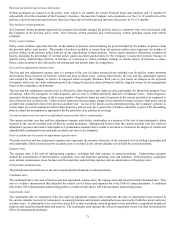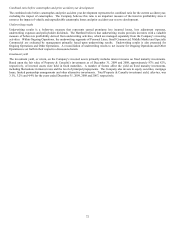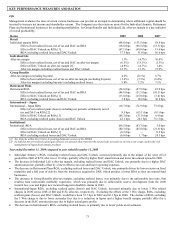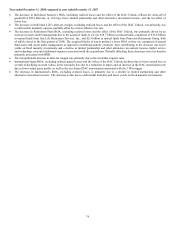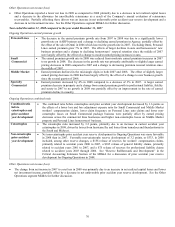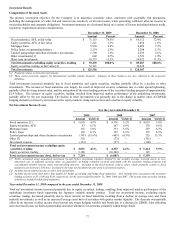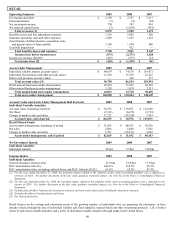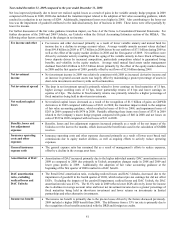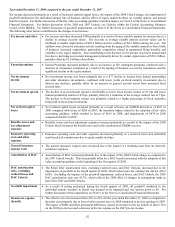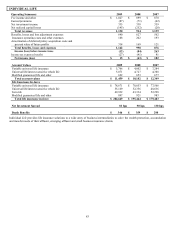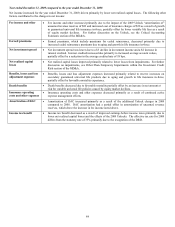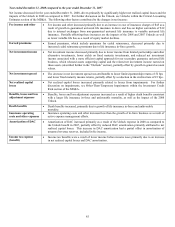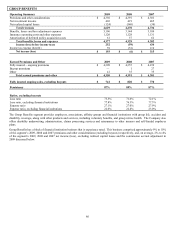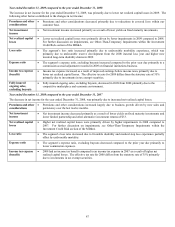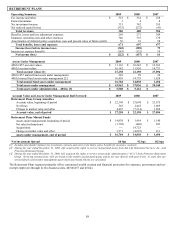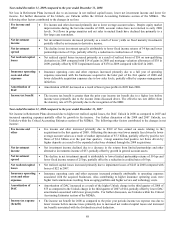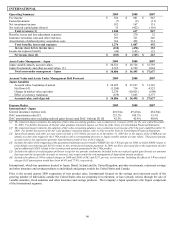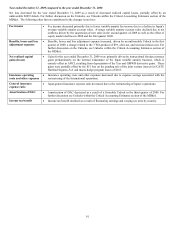The Hartford 2009 Annual Report Download - page 81
Download and view the complete annual report
Please find page 81 of the 2009 The Hartford annual report below. You can navigate through the pages in the report by either clicking on the pages listed below, or by using the keyword search tool below to find specific information within the annual report.
81
Year ended December 31, 2009 compared to the year ended December 31, 2008
Net loss improved primarily due to lower net realized capital losses as a result of gains in the variable annuity hedge program in 2009
compared with losses in 2008; 2008 also included the transition impact related to the adoption of fair value accounting guidance, which
resulted in a reduction in net income of $209. Additionally, impairment losses were higher in 2008. Also contributing to the lower net
loss was the impairment of goodwill attributed to the individual annuity line of business in 2008. These items were offset partially by
lower fee income.
For further discussion of the fair value guidance transition impact, see Note 4 of the Notes to Consolidated Financial Statements. For
further discussion of the 2009 and 2008 Unlocks, see Unlocks within the Critical Accounting Estimates section of the MD&A. The
following other factors contributed to the changes in net income:
Fee income and other • Fee income and other decreased primarily as a result of lower variable annuity and mutual fund fee
income due to a decline in average account values. Average variable annuity account values declined
from $99.8 billion in 2008 to $77.3 billion in 2009 driven by net outflows of $7.1 billion during 2009 as
well as the effect of the equity market declines in 2008 and the first quarter of 2009. Net outflows were
driven by surrender activity resulting from the aging of the variable annuity in-force block of business;
lower deposits driven by increased competition, particularly competition related to guaranteed living
benefits, and volatility in the equity markets. Average retail mutual fund assets under management
declined from $42.4 billion to $35.5 billion driven primarily by the effect of the equity market declines
in 2008 and the first quarter of 2009, partially offset by net flows of $2.0 billion during 2009.
Net investment
income
• Net investment income in 2009 was relatively consistent with 2008 as increased derivative income and
an increase in general account assets was largely offset by maintaining a greater percentage of assets in
short-term investments and lower yields on fixed maturities.
Net investment spread • The drop in net investment spread is primarily related to lower earnings on fixed maturities of 15 bps,
higher average crediting rates of 14 bps, lower partnership returns of 8 bps and lower earnings on
equities of 4 bps. The decline in fixed maturity returns was primarily related to a higher percentage of
fixed maturities being held in short-term investments.
Net realized capital
losses
• Net realized capital losses decreased as a result of the recognition of $1.5 billion of gains on GMWB
derivatives in 2009 compared with losses of $631 in 2008; the transition impact related to the adoption
of fair value accounting guidance, which resulted in losses of $616 in 2008; and impairment losses of
$263 in 2009 compared with $474 in 2008. Partially offsetting these items were losses of $733 in 2009
related to the Company’ s macro hedge program compared with gains of $40 in 2008 and net losses on
sales of $329 in 2009 compared with net losses of $31 in 2008.
Benefits, losses and
loss adjustment
expenses
• Benefits, losses and loss adjustment expenses increased primarily as a result of the net impact of the
Unlocks over the last twelve months, which increased the benefit ratio used in the calculation of GMDB
reserves.
Insurance operating
costs and other
expenses
• Insurance operating costs and other expenses decreased primarily as a result of lower asset based trail
commissions due to equity market declines, as well as ongoing efforts to actively reduce operating
expenses.
General insurance
expense ratio
• The general expense ratio has remained flat as a result of management’ s efforts to reduce expenses,
offset by a decline in the average asset base.
Amortization of DAC • Amortization of DAC increased primarily due to the higher individual annuity DAC amortization rate in
2009 as compared to 2008 due primarily to Unlock assumption changes made in 2008 and 2009 and
lower gross profits in 2009. Additionally, the adoption of fair value accounting guidance at the
beginning of the first quarter of 2008 resulted in a DAC benefit.
DAC amortization
ratio, excluding
realized losses and
DAC Unlocks
• The Retail DAC amortization ratio, excluding realized losses and DAC Unlocks, decreased due to the
impairment of goodwill in the fourth quarter of 2008, which reduced pre-tax earnings but did not affect
EGPs. Excluding the impacts of the goodwill impairment, realized losses and DAC Unlock, the DAC
amortization ratio was 43.3%. The 61.6% ratio in 2009 reflects lower EGPs driven by lower fee income
due to declines in average account value and lower net investment income due to a greater percentage of
fixed maturities being held in short-term investment and lower returns on investments in limited
partnerships and other alternative investments.
Income tax benefit • The income tax benefit is primarily due to the pre-tax losses driven by the factors discussed previously.
2009 included a higher DRD benefit than 2008. The difference from a 35% tax rate is primarily due to
the recognition of tax benefits associated with the DRD and foreign tax credits.


